
The rise was attributed to the seasonal increase of the prices of manufactured products (1.3-per cent rise in March after February’s 0.5-per cent rise) and a slight increase of those of tobacco.
Over a month, the prices of energy decreased by 0.7 per cent in March after a 4.1-per cent rise in February.
Seasonally adjusted, consumer prices fell back by 0.4 per cent in March after a 0.5-per cent rise in February.
Year on year (YoY), consumer prices went up by 2.3 per cent in March after a 3-per cent increase in February. This fall in inflation resulted from the YoY slowdown in the prices of food, services, energy and manufactured products (plus 0.1 per cent in March after plus 0.4 per cent in February).
Core inflation decreased again YoY, reaching 2.2 per cent in March after 2.6 per cent in February.
Energy prices rose by 3.4 per cent YoY in March after a 4.3-per cent YoY rise in February. This slowdown can be explained by the decrease in the prices of gas and the slowdown of those of electricity.
The prices of manufactured products increased by 0.1 per cent YoY in March after a 0.4-per cent increase in February, slowing down for the ninth month in a row.
The prices of clothing and footwear increased slower in March than in February—a 0.4-per cent rise after a 0.9-per cent increase in February.
The upturn in export conditions was led by renewed momentum across Asian markets, where growth on a trade-weighted basis accelerated to the quickest since May 2023. Central to this were faster increases in business activity in China, Japan and India.
Fibre2Fashion News Desk (DS)